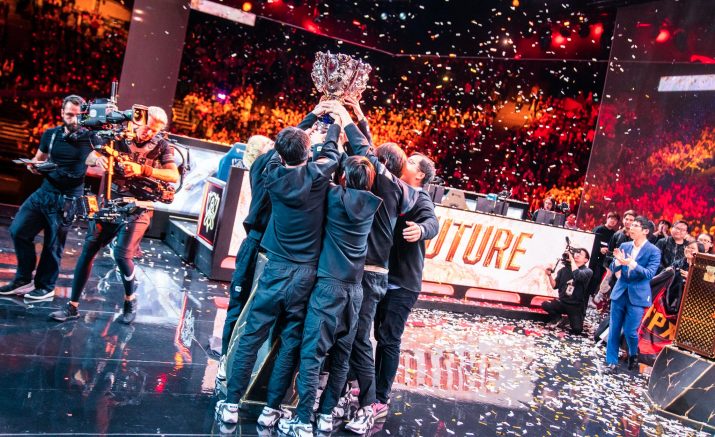Calrec’s RP1 used for coverage of 2019 LoL World Championship final

Victorious FunPlus Phoenix team from China lifts the trophy in Paris 2019 at the Riot Games Championships
Riot Games’ 2019 League of Legends (LoL) World Championship final in Paris used Calrec’s RP1 remote production technology for the English language feed for viewers in North America, Europe and Oceania.
Riot Games installed an Artemis console in Berlin, connected to the RP1 in Paris. The RP1 was used with the on-air talent in Paris and was controlled from Berlin. The on-air talent consisted of three ‘shoutcasters’, also known as game commentators, as well as six analysts.
The majority of the English language feed producers were in Berlin with only a minimal footprint onsite, a key advantage of using remote production technology. As well as IFB for the talent, there was also a mix minus feed that was sent back from Berlin to the RP1 so they could hear video playback, music and so on. Some talent wanted to hear themselves as well as game action, other analysts and shoutcasters, which the RP1/Artemis combination was designed to accommodate.
The IFB for the on-air talent was processed onsite by Calrec’s RP1 to avoid the delay that would occur if it had been routed to Berlin and back, and networked around the Paris site on a DANTE IP network.
This allowed producers to control the talent audio from the console in Berlin. In addition, the Berlin console also handled the overall English language production mix, which was then sent, using Riot Games’ Riot Direct backbone network, to its LA facility for onward distribution.
Dave Talavera, audio engineer at Riot Games, said “When it came to building our new European facility in Berlin two years ago, we knew, given our experience with remote production, that was the path that we wanted to continue down. Calrec was the only company that had come up with a remote production solution for IFB and they are still very much at the forefront of this. This was essential for the remote production of the English language feed for the final in Paris.”
Talavera added: “We were very pleased with what we achieved with Calrec’s remote production technology. It did exactly what it’s designed to do and was great. We are very firm believers in remote production as it saves production costs in the long run and that’s money that can be spent improving other aspects. This system proved that it works and saved the costs we anticipated.”
Dave Letson, VP of sales, Calrec, commented: “We worked very hard developing our RP1 system, listening to customer requirements and therefore clearly understanding how to create technology that satisfied those. We are very pleased that Riot Games recognises this. We are witnessing broadcasters starting to reap the benefits in terms of remote production, across eSports and, of course, more widely across the production sector. Remote production has now been adopted on a wider basis and has really taken off as an alternative to traditional workflows.”
